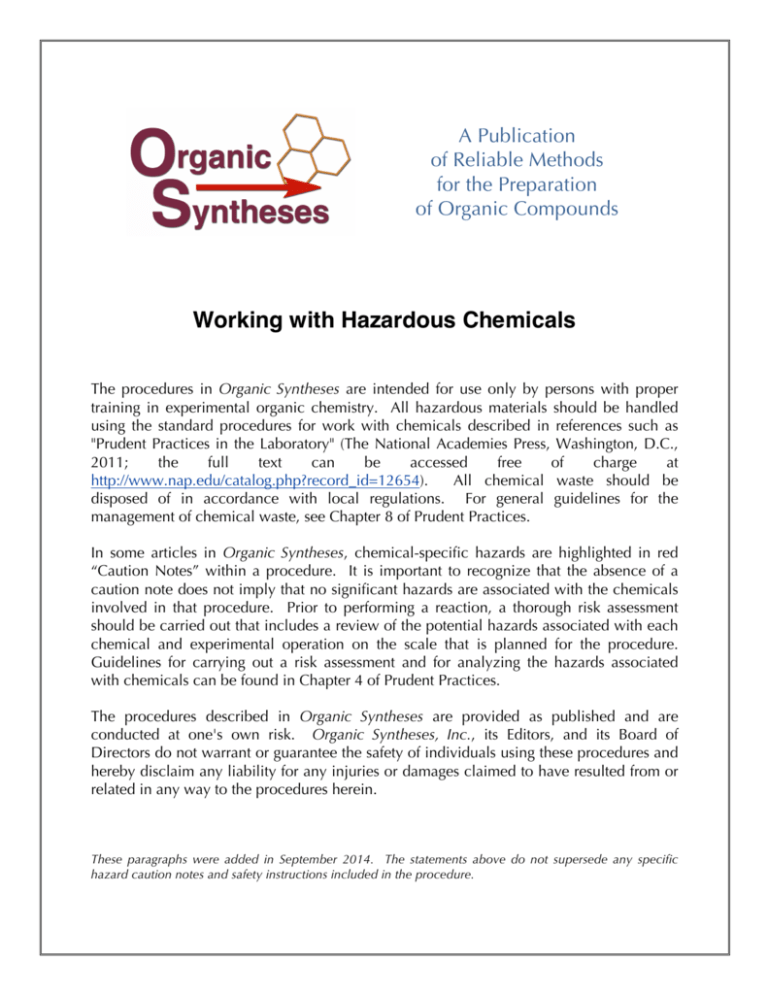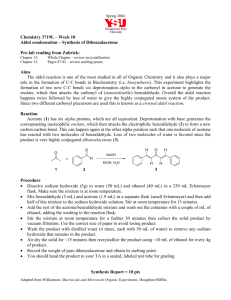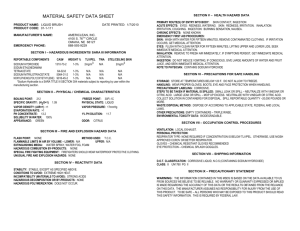
A Publication
of Reliable Methods
for the Preparation
of Organic Compounds
Working with Hazardous Chemicals
The procedures in Organic Syntheses are intended for use only by persons with proper
training in experimental organic chemistry. All hazardous materials should be handled
using the standard procedures for work with chemicals described in references such as
"Prudent Practices in the Laboratory" (The National Academies Press, Washington, D.C.,
2011;
the
full
text
can
be
accessed
free
of
charge
at
http://www.nap.edu/catalog.php?record_id=12654).
All chemical waste should be
disposed of in accordance with local regulations. For general guidelines for the
management of chemical waste, see Chapter 8 of Prudent Practices.
In some articles in Organic Syntheses, chemical-specific hazards are highlighted in red
“Caution Notes” within a procedure. It is important to recognize that the absence of a
caution note does not imply that no significant hazards are associated with the chemicals
involved in that procedure. Prior to performing a reaction, a thorough risk assessment
should be carried out that includes a review of the potential hazards associated with each
chemical and experimental operation on the scale that is planned for the procedure.
Guidelines for carrying out a risk assessment and for analyzing the hazards associated
with chemicals can be found in Chapter 4 of Prudent Practices.
The procedures described in Organic Syntheses are provided as published and are
conducted at one's own risk. Organic Syntheses, Inc., its Editors, and its Board of
Directors do not warrant or guarantee the safety of individuals using these procedures and
hereby disclaim any liability for any injuries or damages claimed to have resulted from or
related in any way to the procedures herein.
These paragraphs were added in September 2014. The statements above do not supersede any specific
hazard caution notes and safety instructions included in the procedure.
DOI:10.15227/orgsyn.012.0022
Organic Syntheses, Coll. Vol. 2, p.167 (1943); Vol. 12, p.22 (1932).
DIBENZALACETONE
[3-Pentanone, 1,5-diphenyl-]
Submitted by Charles R. Conard and Morris A. Dolliver.
Checked by H. Lohse and C. R. Noller.
1. Procedure
A cooled solution of 100 g. of sodium hydroxide in 1 l. of water and 800 cc. of alcohol (Note 1) is
placed in a 2-l. wide-mouthed glass jar which is surrounded with water and fitted with a mechanical
stirrer. The solution is kept at about 20–25° and stirred vigorously (Note 2) while one-half of a mixture
of 106 g. (1 mole) of benzaldehyde and 29 g. (0.5 mole) of acetone is added (Note 3). In about two or
three minutes a yellow cloud forms which soon becomes a flocculent precipitate. After fifteen minutes
the rest of the mixed reagents is added, and the container is rinsed with a little alcohol which is added to
the mixture. Vigorous stirring is continued for one-half hour longer, and the mush is then filtered with
suction on a large Büchner funnel. The product is thoroughly washed with distilled water (Note 4) and
then dried at room temperature to constant weight. The yield is 105–110 g. (90–94 per cent of the
theoretical amount) (Note 5) of a product which melts at 104–107°.
The crude dibenzalacetone may be recrystallized from hot ethyl acetate, using 100 cc. of solvent for
each 40 g. of material. The recovery in this purification is about 80 per cent; the purified product melts
at 110–111°.
2. Notes
1. Sufficient alcohol is used to dissolve the benzaldehyde rapidly and to retain the benzalacetone in
solution until it has had time to react with the second molecule of aldehyde. Lower concentrations of
base slow up the formation of the dibenzalacetone and thus favor side reactions which yield a sticky
product. Higher concentrations of base give added difficulty in washing. These concentrations were
suggested by, and are approximately the same as, those used in the preparation of benzalacetophenone
described in Org. Syn. Coll. Vol. I, 1941, 78.
2. Only temperatures between 20 and 25° were tried; it was assumed that a change of temperature would
have the same effect that it has in the preparation of benzalacetophenone mentioned above.
Stirring is essential, as it makes considerable difference in the uniformity of the product.
3. The benzaldehyde was u.s.p. quality which had been washed with sodium carbonate solution and
distilled. Commercial c.p. acetone was used. The theoretical quantities are used, since an excess of
benzaldehyde results in a sticky product while an excess of acetone favors the production of
benzalacetone. The mixture is prepared before addition in order to ensure additions of equivalent
quantities.
4. Since the product is practically insoluble in water, large amounts can be used in the washing. Sodium
compounds are probably the chief impurities. The dried product contains some sodium carbonate which
results from the failure to remove the sodium hydroxide completely. There remain also the impurities
insoluble in water. However, the product is pure enough for use in most reactions.
5. If the mush is allowed to stand several hours, chilled, and filtered cold, a slightly larger yield is
obtained, but this is not worth while. The filtrate may be used as a medium for a second run in which
about 93 per cent of the theoretical yield is obtained. The melting point of the second product is slightly
lower.
3. Discussion
Dibenzalacetone has been prepared by condensing benzaldehyde with acetone using as condensing
agents dry hydrogen chloride,1 10 per cent sodium hydroxide solution,2 and glacial acetic acid with
sulfuric acid.3 It has also been obtained by condensing benzalacetone with benzaldehyde in the presence
of dilute sodium hydroxide.4 Straus and Ecker5 were the first to record the use of ethyl acetate for
crystallization.
References and Notes
1. Claisen and Claparède, Ber. 14, 350 (1881).
2. Schmidt, ibid. 14, 1460 (1881); Claisen, ibid. 14, 2470 (1881); Straus and Caspari. ibid. 40, 2698
(1907).
3. Claisen and Claparède, ibid. 14, 2460 (1881).
4. Claisen and Ponder, Ann. 223, 141 (1884).
5. Straus and Ecker, Ber. 39, 2988 (1906).
Appendix
Chemical Abstracts Nomenclature (Collective Index Number);
(Registry Number)
alcohol (64-17-5)
sulfuric acid (7664-93-9)
hydrogen chloride (7647-01-0)
acetic acid (64-19-7)
ethyl acetate (141-78-6)
sodium hydroxide (1310-73-2)
sodium carbonate (497-19-8)
Benzalacetophenone (94-41-7)
benzaldehyde (100-52-7)
acetone (67-64-1)
Benzalacetone (122-57-6)
Dibenzalacetone (35225-79-7)
3-Pentanone, 1,5-diphenylCopyright © 1921-2005, Organic Syntheses, Inc. All Rights Reserved






